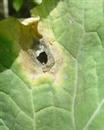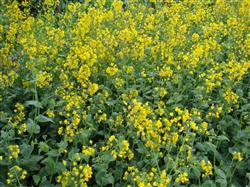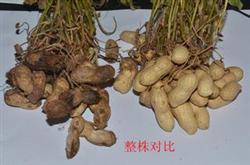Opinions on the occurrence and control of Sclerotinia sclerotiorum in rape

The growth period of rape this year is earlier than that of last year, and its growth is close to that of last year. The incidence characteristics of Sclerotinia sclerotiorum in rape this year are different from those in previous years. According to the comprehensive analysis of many factors, such as the source of bacteria in the field, the growth of rape, the disease resistance of varieties and the climatic conditions of susceptible growth period, the degree of natural occurrence is moderately prevalent. 1. According to the field bacterial source, the sclerotia was surveyed from March 7 to 9, the average number of ascomycetes per mu was 1425, the highest was 7800; the ascomycetes began on March 2, 6 days earlier than usual, which belongs to the year of early onset of fungal sources. the peak period of spore release is expected to be from March 26 to April 8, which coincides with the flowering stage of rape. 2. Variety resistance accounts for more than 90% of the area of high-quality rape planted in our region this year. "Huyou 15" and "Huyou 12" are all susceptible varieties, and the resistance is also decreasing year by year. Once favorable climatic conditions are encountered, the disease will spread rapidly. 3. The rape seedling condition is better than that in previous years, according to the summary of the startling seedling stage of the Food and Economics Section of the District Agricultural Technology Center, the rape seedling condition is better than the same period of the previous three years, and the growth process is close to that of previous years. The current rape field microclimate is beneficial to the infection and spread of the pathogen. 4. The susceptible growth period and climatic conditions of rapeseed will enter the flowering stage in late March, and the flowering period will be from the end of March to the first ten days of April. According to the climate analysis of this area, from the first ten days of April to the last ten days of April, the rain days are 3-4 days, 4 days and 3-4 days respectively, the rainfall is 15-30 mm, 20-40 mm and 15-25 mm respectively, and the average temperature is 13-14 ℃, 14-15 ℃ and 16-17 ℃ respectively. During the susceptible growth period, the rain day, rainfall and air temperature can meet the epidemic of the disease. Second, opinions on prevention and control of Sclerotinia sclerotiorum must adopt the strategy of "prevention first, comprehensive control". Once the symptoms are shown on rape, and then take control measures, the effect is poor. Therefore, we must grasp the appropriate period of control and timely use of drugs, resolutely overcome paralysis and fluke psychology, and strive for the initiative to ensure the high yield of rape this year. 1. Agricultural prevention and control should continue to do a good job in cleaning up the ditch system so that there is no stagnant water in the rain, so as to reduce the groundwater level and field humidity and improve the disease resistance of rape. 2. Chemical control (1) the appropriate period of control: control once in the early flowering stage of rape, and in case of rainy weather in full bloom, prevent it again every 7-10 days. (2) Control agents: 70 grams (1 pack) of 25% gibberellin per mu (10% imidacloprid 30 grams per mu where rape aphids occur heavily) small machine with 50 kg water spray or large machine with 20 kg water spray. When spraying, pay attention to spray on the middle and lower stems and leaves of rape in order to improve the control effect.
- Prev

Symptomatic control of rape stiff seedlings
In the early stage of field growth after transplanting slow seedlings, rigid seedlings sometimes appeared, such as reddish leaves and yellow leaves, leaf center curls, slow growth or cessation of growth, poor growth and so on. Targeted measures should be taken to prevent and control rape stiff seedlings on the basis of investigating the causes of stiff seedlings. The drought of stiff seedlings caused by drought or waterlogging not only leads to.
- Next

Double improvement of yield and quality in comprehensive prevention of peanut fruit rot
Peanut fruit rot is also known as "peanut rot disease". In recent years, the disease is more common in the main peanut producing areas in our province, such as Daming, Xinle, Dingzhou, Xingtang, Luan County and so on, especially when Rain Water is encountered in the podding period of continuous cropping for many years. The disease will be more serious. According to the survey, if the infected land is light, the yield will be reduced by 20%.
Related
- The first cup of black tea in spring, the flavor and history of tea gardens in Kenya, Africa
- The computer can not only choose potatoes, but also grow tea rice. AI will grow winter oolong tea champion.
- It is not only the inflated tea bitten by insects, but also engraved with the four seasons tea in Beipu.
- The Oriental Beauty Tea Festival in Zhuxian County takes the stage at the weekend to experience the plus-size feast of oil tea.
- & quot; Oriental Beauty Tea & Exploration of Emei in Hsinchu, the hometown of quot;
- The new variety of strawberry "Tainong 1" dessert is the first choice with mellow aroma. Crimson gorgeous
- History of Tea in Taiwan: from Wild Inner Mountain to Export Tea Garden
- Two types of Taiwan Oriental Beauty Black Tea won the British three-Star Award for Childhood Tea Xiang Zhang Jiaqi changed from pilot to champion tea maker.
- Banana species and varieties: the planting history of Taiwan Xianren banana and dwarf banana is long, is banana disease resistant?
- Coffee planting Technology: Qianjie Coffee from Seedling to harvesting

